A Practical Guide to 2010 ADA-Compliant Restroom Design
![]() Continuing Education
Continuing Education
Use the following learning objectives to focus your study while reading this month’s Continuing Education article.
Learning Objectives - After reading this article, you will be able to:
- Explore the reasons accessible design is important in professional practice.
- Explain the latest changes in accessibility requirements as they apply to restroom design.
- Address key considerations for creating compliant restrooms.
- Select restroom equipment that is compliant with the latest ADA accessibility standards.
The rules defining acceptable accessible design have recently changed, forcing many in the design community, from seasoned and senior architects to junior associates and other design professionals, to take a closer look at the new Americans with Disabilities Act (ADA) Standards for Accessible Design. On March 15, 2012, the revised regulation, the 2010 ADA Standards for Accessible Design, also referred to as the 2010 ADA Standard, became the new, legally enforceable requirement for ensuring a space is readily accessible to and usable by individuals with disabilities.
This new standard has even broader reach than its 1991 predecessor, applying to newly designed and constructed or altered state and local government facilities, public accommodations, commercial facilities, recreational facilities, detention facilities, courthouses and more, and includes a number of significant and material changes to the existing accessibility requirements. “The new ADA standard has been changed just slightly enough that even experienced design veterans, if they're not paying attention, can make mistakes,” says Judy Girod, FASID, CID, director of interior design at Lothrop Associates in New York.
Restrooms are one of the room types where there are a considerable number of ADA stipulations to satisfy and where many of the newly revamped regulations apply. The 2010 ADA Standard stipulates that “where toilet rooms are provided, each toilet room shall comply…” so, generally speaking, any restroom designed in a local or state government building, public accommodation, commercial facility, recreational facility, detention facility, courthouse, etc. is required, by law, to be in compliance with the ADA. The requisite mix of toilet compartments, necessary clear floor space, turning space, door placement and fixture mounting height are just a few of design elements that are addressed and regulated in the ADA Standard.
 |
For example, the 2010 ADA Standard mandates that “where toilet compartments are provided, at least one toilet compartment shall comply with 604.8.1.” Section 604.8.1 details the specifications for a wheelchair-accessible stall. So another way to read the ADA mandate is that wherevesr toilet compartments are provided, at least one toilet compartment shall be wheelchair accessible, as defined by the ADA. The standard also states that one ambulatory stall is required for every six water closets located in the toilet room or when the combination of urinals and water closets totals six or more fixtures.
The standard also imposes strict regulations on the lavatory area in a restroom. “Where lavatories are provided, at least one shall comply with ADA Section 606 and shall not be located in the toilet compartment” (2010 ADA Standard, Section 213.3.4). Section 606 addresses important topics such as mounting height, turning room, clear floor space requirements, etc. Generally speaking, the ADA sphere of influence is so broad that unless the building or project space is specifically identified as an exception, at least one ADA-compliant sink and toilet compartment is required for each restroom.
 |
Image courtesy of The ASI Group adapted from the 2010 ADA Standard The 2010 ADA Standard requires that highest edge of the changing deck be no higher than 34 inches AFF. The baby changing station shown here is non-compliant. |
It is important to note that the ADA is not a building code; it is civil rights legislation, so the potential penalties for non-compliance carry some significant bite. Beyond delaying a Certificate of Occupancy, facilities that are found to be in violation of the ADA standard can incur steep fines and even be targeted in lawsuits by the Department of Justice (DOJ). Regarding fines, the first offense can carry a civil penalty of $55,000 and a second offense $110,000 and so on. The DOJ has the ability to bring class action lawsuits on behalf of individuals with disabilities, and if there's a finding of liability, there could be a significant monetary burden on a facility. The DOJ can also seek damages for people who are aggrieved and injunctive relief that will force a facility to make the required changes.
In short, the 2010 ADA Standard applies to many of the restrooms standing, under construction or currently being designed in the United States. Compliance is important not only to ensure that individuals with permanent or temporary disabilities can use the space, but also to protect the facility and its ownership from the potential fines and legal action that non-compliance can invite.
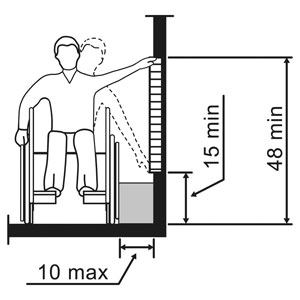 |
Image courtesy of The ASI Group adapted from the 2010 ADA Standard The new acceptable, unobstructed reach range is now between 15 and 48 inches AFF, according to the 2010 ADA Standard. |
Changes in the 2010 ADA Standard that Apply to Restrooms
The 2010 ADA Standard contains significant changes to the original ADA stipulations and many of those modifications apply to designing accessible restrooms. The restroom-specific changes include: lowering the maximum reach range, increasing the clear floor space required around a water closet, and changing the placement requirements for the centerline of the water closet itself.
New Reach RangesThe 2010 ADA Standard defines a reach range with minimum and maximum heights for the operable mechanisms on fixtures and accessories. The intent of the reach range is to ensure that a disabled person, perhaps sitting in a wheelchair or using a cane, will be capable of reaching and operating the paper towel dispenser, baby changing table or other restroom equipment.
The reach range defined in the 2010 ADA Standard incorporates significant changes to the reach range mandated by the 1991 standard. Under the 1991 standard, the reach range was dependent upon the type of approach that would be used. The maximum height for an unobstructed side approach was 54 inches above finished floor (AFF), whereas an unobstructed front approach had a lower maximum height of 48 inches AFF. The 2010 ADA Standard has consolidated the two reach ranges into one. Now the maximum acceptable height for hand dryer push buttons, or any other operable mechanism, is 48 inches AFF and the lowest acceptable height is 15 inches AFF, regardless of approach.
Compliance issues can arise when a designer is detailing the mounting heights of restroom equipment and forgets that the reach range mandates the position of the operable mechanism (i.e., the towel slot, the push knob) and not the top or bottom of the accessory. Many times accessories shown on interior elevation drawings are positioned in terms of the top or bottom of the accessory, instead of detailing the maximum dimension to the operating part.
Now Including Standards for ChildrenAnother difference between the 1991 standard and the 2010 ADA Standard (section 308.1) is that the 2010 standard outlines acceptable reach ranges for children according to age. These reach ranges are intended to be used when elements like coat hooks, lockers, toilet compartments, lavatories, and other fixtures and accessories will be primarily used by children.

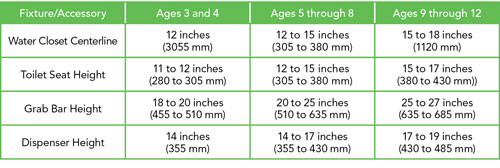
The 2010 ADA Standard provides an advisory specifically focused on specifying toilet compartments for children's use (section 604.9). The table on the next page provides additional guidance for specifying toilet compartments for children according to the age group served and reflects the differences in size, stature and reach ranges of children ages 3 through 12. It is suggested that the chosen specifications correspond to the primary user group.
Increased Clear Floor Space Around the Water ClosetClear floor space (CLFS) is defined as the minimum unobstructed floor or ground space required to accommodate a single, stationary wheelchair and occupant. The 2010 ADA Standard is increasing the amount of clear floor space that is required around a water closet. According to section 604.3.1, clearance around the water closet shall be 60 inches minimum measured perpendicular from the side wall, 56 inches minimum measured perpendicular from the rear wall for a wall-hung water closet, and 59 inches minimum measured from the rear wall for a floor-mounted water closet. This increased clear floor space is allowed to overlap the water closet, grab bars, toilet paper dispensers, sanitary napkin disposal units, coat hooks, shelves, accessible routes and turning space. No other fixtures or obstructions shall be located within the required water closet clearance.
New Centerline for the Water ClosetUnder the 1991 standards, the centerline for the water closet, which refers to the space from the side wall to the center of the toilet, was required to be an absolute 18 inches. Under the 2010 ADA Standard, the centerline of the water closet must fall within an established range of 16 inches minimum to 18 inches maximum from the side wall or partition. The centerline of the water closet in an ambulatory-accessible compartment can be between 17 and 19 inches from the side wall or partition.
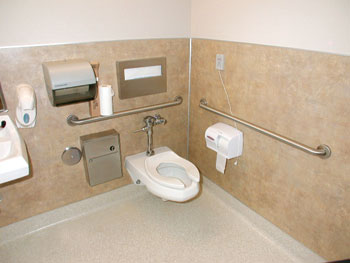 |
|
Photo courtesy of The ASI Group In this non-compliant example, the seat cover dispenser does not have the requisite clear floor space for wheelchair use. |
Arguably one of the most anticipated changes in the 2010 ADA Standard is the inclusion of construction tolerances. “Speaking practically about restroom design, it is quite common that there may be a slight variance in the measurement identified in the drawing and the actual tile and porcelain implementation. It is usually close, but rarely exact,” explains Michael Chambers, FAIA, FCSI, CCS, principal at MCA Specifications in Ukiah, California. “In the old standard, if the toilet was not exactly 18 inches at the centerline, it was non-compliant. The 2010 ADA Standard recognizes the reality of construction tolerances and has replaced many of the absolute values with acceptable ranges for placement.”
Additional Considerations for ADA-Compliant Restrooms
Many of the 2010 ADA Standard's requirements that apply to restroom design remained the same from one standard to the other, but they are no less critical to creating compliant restrooms. Here we will review seven key considerations that must be incorporated into any ADA-compliant design.
Maintain Clear Width DimensionsThe 2010 ADA Standard mandates that specific clear width dimensions must be maintained throughout an accessible route so that a person with a disability can move freely through the space, without being required to weave around a room full of obstacles. Specifically the code identifies the clear width of the accessible route shall be 36 inches minimum and also requires that door openings provide a clear width of 32 inches minimum. Openings more than 24 inches deep shall provide a clear opening of 36 inches minimum.
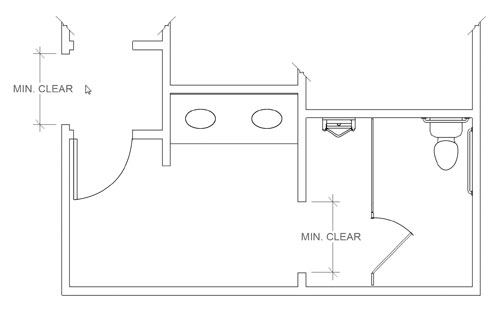 |
|
Image courtesy of The ASI Group adapted from the 2010 ADA Standard Stipulate “minimum clear” on the drawing to safeguard important clear width dimensions. |
The most common places where clear width compliance issues are found are at vestibule entry points and at passageways through the walls. The problem often arises from a simple measuring mistake. Clear openings with swinging doors, for example, must be measured between the face of the door and the stop, where the door is open 90 degrees. One way to avoid an issue in these areas is to identify these clear width dimensions on the drawings where they occur. Designers can stipulate a “minimum clear” or to “hold this dimension” on the drawing, where necessary.
Provide Clear Floor SpaceAs mentioned previously, clear floor space describes the minimum unobstructed floor or ground space required to accommodate a single, stationary wheelchair and occupant. The 2010 ADA Standard requires a 30-inch by 48-inch clear space minimum at every fixture, accessory and operable piece of hardware in a restroom, with the exception of the water closet which now requires a larger clear floor space. This requirement ensures that a person in a wheelchair can roll up to the fixture or accessory, such as a toilet cover dispenser, with either a forward or parallel approach, and use it appropriately.
The sheer number of fixtures and accessories typically found in a restroom can make it challenging for a designer to carve out enough clear floor space to be compliant. In fact, not providing enough clear floor space to accommodate a wheelchair at every accessory is one of the most common ADA violations seen in restrooms. Unfortunately, creating acceptable clear floor space is slightly more involved than simply drawing a 30-inch by 48-inch rectangle under each fixture or accessory on the floorplan. Clear floor space for a sink can include the space underneath the sink all the way to the wall, if there is appropriate clearance for a wheelchair and occupant to fit underneath the sink. Clear floor space for accessories and sinks must adjoin the accessible route or path of travel through the restroom. And, generally speaking, door swings may not impinge on clear floor space.
Turning Space RequiredThere are only three room types that are required by the ADA to offer adequate turning space. They are dressing rooms, hospital patient rooms and restrooms. In the restroom, turning circles are only required in the main toilet room, not in the accessible stall, and designers may use either a turning circle or T-shaped space to meet the requirement.
In the 2010 ADA Standard, section 304.3.1, the turning circle is defined as a space of 60 inches in diameter minimum that also includes knee and toe clearance in compliance with section 306. Section 306 defines acceptable knee and toe clearance as the vertical space between 9 inches and 27 inches AFF with a minimum depth requirement of 11 inches deep at 9 inches AFF for toes and 8 inches deep at 27 inches AFF for knees.
The parameters of the T-shaped turning space are a 60-inch-square minimum with arms and base that are a minimum of 36 inches wide. Each arm of the T shall be clear of obstructions 12 inches minimum in each direction and the base shall be clear of obstructions for 24 inches minimum. The T-shaped turning space will also include knee and toe clearance complying with 306, identical to the turning circle requirements, but are only required at the end of either the base or one arm.
Turning space and the required clear floor space for fixtures and accessories are allowed to overlap. When the requisite turning space must occur underneath another restroom fixture or accessory, make certain that the appropriate under-counter clearance for knees is provided.
Clear Door SwingsThe 2010 ADA Standard specifies a number of conditions to ensure that individuals with disabilities can enter and exit the restroom without excessive hardship and can occupy a restroom space without being forced to constantly maneuver around an opening and closing door. To that end, in typical restroom applications, doors are not allowed to swing into the clear floor space that belongs to any fixture or accessory; however they are permitted to swing into established turning areas.
As part of the accessible route, restroom doors shall provide a minimum clear width of 32 inches and there must be enough clear floor space on either side of the door to accommodate the door swing and maintain the minimum clear width of 36 inches along the path of travel. Safeguard compliance in these problematic areas by indicating the clear width dimensions on the drawings and being cognizant of the fact that dimensional errors and even the depth of the finish on the door can erode the requisite clear width minimums.
Remove Protruding Objects from the Path of TravelFor the purpose of restroom design, the basic definition of a protruding object is anything that extends more than four inches from the vertical surface between 27 and 80 inches AFF. Generally this applies to paper towel dispensers, hand dryers and semi-recessed trash containers, but can include signs, wall sconces, shelves, window sills, etc. Keep protruding objects out of the path of travel by positioning signage a minimum of 80 inches AFF, locating protruding dispensers in corners outside of the path of travel, and exploring the growing number of restroom accessories that are being designed in thinner frames, eliminating the presence of protruding objects in the restroom space altogether.
Create an Accessible Route or Path of TravelAn accessible route is defined in the 2010 ADA Standard as a continuous, unobstructed path connecting all accessible elements and spaces of a building. It is essentially the path that a disabled person uses to enter any space and move through it to the last accessible fixture. In the case of a restroom, the accessible route is the path that a person with a wheelchair, cane or cast would use to open the door, enter the restroom, travel past the regular stalls to reach the wheelchair-accessible compartment and then traverse back to use the accessible sink, hand dryer and even the baby changing station before leaving.
The 2010 ADA Standard requires that a 36-inch minimum width must be maintained along the entire path of travel. While door swing is not allowed to impinge upon the mandated width of an accessible route, both designated clear floor space areas and turning space are allowed to overlap with the 36-inch-wide path of travel.
There is a common misconception that if a fully abled person can weave his or her way through a restroom to the wheelchair accessible stall, the path of travel mandate has been satisfied. In reality, the space must provide enough clear floor space, turning radius and under-counter clearance for a person with a wheelchair or cane to move through the space without being forced to maneuver around obstructions and without the threat of protruding objects creating potential safety hazards.
Eliminate Grasping, Pinching and TwistingMore than providing a person with a disability a safe and possible passage through a restroom to the accessible stall, the 2010 ADA Standard includes regulations that ensure that a person with a disability will be able to operate the various fixtures and accessories as well. Section 309.4 of the 2010 ADA Standard states that “operable parts shall be operable with one hand and shall not require tight grasping, pinching, or twisting (GPT) of the wrist.” This mandated moratorium on GPT is intended to create restroom spaces where a person with a prosthetic hand can still open and secure compartment doors, turn sink faucets on and off, and operate hand dryers, paper towel dispensers and feminine napkin dispensers as needed.
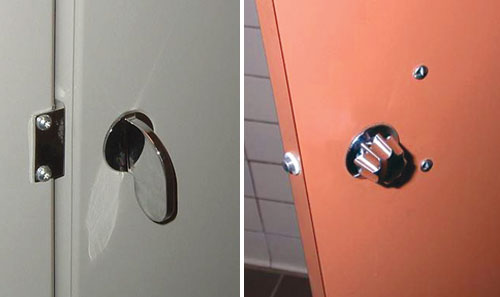 |
|
Photo courtesy of The ASI Group ADA-compliant door handles must be able to be manipulated without requiring tight grasping, pinching or twisting of the wrist, making lever hardware a popular and compliant alternative to knobs that twist. |
In order to create this GPT-free environment, lever handles and push buttons have become the popular operating mechanisms specified throughout restrooms, but creating a truly accessible restroom requires specifiers to think beyond basic product features to the total user experience. For example, there are feminine hygiene product dispensers that dispense napkins for one or two coins with the push of a button. While the push button dispensing mechanism is certainly compliant with the 2010 ADA Standard, some machines need a deposit to operate, which requires that a person be able to grasp a coin and drop it into the coin slot. It is noted that the scope of the ADA Standards is limited to the built environment. However people with disabilities that make GPT difficult [or problematic], may have issues manipulating personal property, such as coins, into a coin slot for pay-per-use dispensers, thus making a dispenser that is technically ADA compliant more difficult to use.
Selecting and Positioning ADA-Compliant Restroom Equipment
With the 2010 ADA Standards defining accessible design and the extensive variety of fixtures and accessories now available, which types of products, product features and placement tips best support the efforts of a specifier to create an ADA-compliant restroom?
Toilet Compartment DoorsThere are many important ADA requirements that must be taken into account when selecting and positioning a toilet compartment door. For example, the placement of the compartment door is critical to ADA compliance. Section 604.8.1.2 stipulates “the stall door must be on the opposite wall/diagonal from the water closet and within 4 inches maximum from the stall corner.” The standard also mandates that toilet compartment doors not swing into the minimum required compartment area. This gives a specfier two options: either design toilet compartments large enough to accommodate the door swing in addition to the minimum required compartment area or specify that the toilet compartment doors will swing out of the toilet compartment. In addition, operable mechanisms on the door for opening and closing and also locking and unlocking must be able to be manipulated without requiring tight grasping, pinching or twisting (GPT) of the wrist. Specifiers should seek out doors that employ levers or sliders as their operable hardware.
Grab BarsThe ADA requires that grab bars be installed in both wheelchair accessible and ambulatory toilet compartments. While there are a few feature-specific requirements in the code, such as the requirement that the grab bars must be able to resist a 250-pound vertical load, the vast majority of the considerations that must be addressed for compliant design are concerned with location, location, location.
The 2010 ADA standard stipulates that grab bars shall be mounted between 33 inches and 36 inches AFF measured to the top of the gripping surface. In wheelchair accessible toilet compartments, grab bars shall be provided on the side wall closest to the water closet and on the rear wall. The side wall grab bar must be a minimum of 42 inches long and must be located 12 inches maximum from the rear wall. The rear wall grab bar shall be a minimum of 36 inches long and extend from the centerline of the water closet 12 inches minimum on one side and 24 inches minimum on the other side. Ambulatory stalls are equipped with two parallel grab bars to accommodate a person that is on crutches, using a walker, or who otherwise requires extra support to transfer onto the water closet. The size and placement requirements for these parallel grab bars mirror the requirements for the side-wall grab bar in the wheelchair accessible stall. The grab bars shall be 42 inches long minimum, located 12 inches maximum from the rear wall and extending 54 inches minimum from the rear wall.
Clearances above and below the grab bars are critical to their effective use. The 2010 standard requires a minimum clearance of 12 inches above the grab bar and a minimum clearance of 1.5 inches below. Specifiers must also ensure that there is exactly an inch-and-a-half clearance between the grab bar and the wall. This amount of space allows a person to get his fingers around the grab bar and establish a solid grip, but is narrow enough to protect an occupant from falling through. It is also mandated that grab bars are mounted onto walls with a smooth surface and cannot be positioned in a way that causes them to intrude upon the clear floor space required by another fixture or accessory.
When specifying the materials for either a wheelchair accessible or ambulatory toilet compartment, confirm that there is adequate backing in the wall or reinforcing in the partition panel to firmly anchor the grab bar in place.
While the focus of this article is compliance with the new 2010 ADA Standard, it is important to note that there are significant differences between the requirements outlined in the 2010 ADA Standards and many State codes. With some minor differences, the 2010 ADA Standards and ICC/ANSI A117.1 are in agreement.
Toilet Compartment AccessoriesToilet compartment accessories refer to toilet paper dispensers, sanitary napkin disposal units, fold-up shelves and combination units. Remember each accessory in the wheelchair accessible toilet compartment requires a clear floor space minimum of 30 inches by 48 inches. This allows an individual to roll up to the accessory and manipulate it with ease. Partition-mounted combination units are popular, because they combine up to six essential components into one compact, easily installed and easily serviced unit that maximizes clear floor space in small areas, however, the mounting heights of these units need to be carefully detailed, because they can conflict with the grab bars if not correctly installed.
Toilet compartment accessories should be mounted within the reach range established in the 2010 ADA Standard, which mandates that the operable mechanism of the accessory be mounted no lower than 15 inches and no higher than 48 inches AFF.
Please note that in terms of specific placement requirements there can be conflicts between the stipulations in the 2010 ADA Standard and building codes. For example, with regard to toilet paper dispenser placement, the 2009 ICC/ANSI A117.1 details dimensions in terms of the distance from the back wall to the leading edge of the accessory and not from the toilet lip to the accessory centerline, as is stipulated in the 2010 ADA Standard.
LavatoriesA wheelchair accessible sink and counter are perhaps two of the trickiest, or least understood, elements specified in a washroom. There are a number of dimensions that must be considered and correctly specified in order to be sure that a person and their wheelchair can fit comfortably underneath, while keeping the countertop and faucet at an acceptable height. The 2010 ADA Standard states that the sink rim and counter surface should be mounted as not to exceed a 34 inch maximum AFF. While acceptable knee and toe clearance is defined as the vertical space between 9 inches and 27 inches AFF with a minimum depth requirement of 11 inches deep at 9 inches AFF for toes and 8 inches deep at 27 inches AFF for knees. An important product feature of any lavatory specified for a wheelchair accessible application is that it must be less than seven inches thick, so the top of the lip can be mounted at 34 inches and the bottom will not interfere with the knee clearance needed at 27 inches AFF.
The lavatory requires the minimum clear floor space of 30 inches by 48 inches, identical to the clear floor space required by any accessory in the toilet room or lavatory accessory. The clear floor space needed by the sink can go all the way to the wall as long as there is no obstruction.
Lavatory AccessoriesLavatory accessories include paper towel dispensers, soap dispensers, hand dryers, mirrors and waste receptacles. Critical compliance issues that are important to address when specifying and positioning these accessories include: verifying the minimum clear floor space requirements have been met, specifying products with operating mechanisms that do not require grasping, pinching or twisting of the wrist , and ensuring the path of travel is free from protruding objects. It should be noted that many manufacturers are making much thinner hand dryers these days, so the protrusion issue is getting easier to avoid.
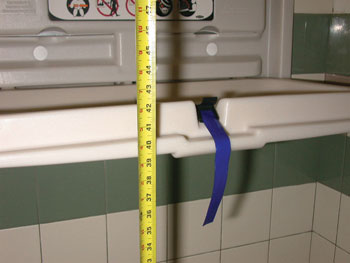 |
|
Photo courtesy of The ASI Group The 2010 ADA Standard requires that highest edge of the changing deck be no higher than 34 inches AFF. The baby changing station shown here is non-compliant. |
The baby changing station is another washroom item that is often found to be non-compliant with ADA regulations. Overwhelmingly, the issue is that the changing station is mounted at an incorrect height. The station must be mounted so that the deck height, when deployed, is between 28 inches and 34 inches AFF. The measurement that must be used to determine deck height is the distance from the floor to the highest edge or lip of the pull-down deck, not the bed of the changing deck. The reason for this is that the deck placement must not require an individual using the changing station to lift a baby any higher than 34 inches AFF. If the baby must be lifted to 35 or 36 inches to get over the lip, the product is not compliant. The highest point on the deck that the child will need to be lifted over is the critical measurement here and it must fall within the 28 to 34 inches range.
In addition to the acceptable height of the deck, the handle that is used to pull the changing station into position cannot exceed the ADA-defined reach range maximum of 48 inches AFF. Depending upon the changing station used, these two requirements, deck height and handle height, can be in conflict with one another. When some products are specified, placing the handle at 48 inches AFF may position the deck lower than the 28 inches AFF minimum that is acceptable. Try to specify a changing station that will not create this issue.
While the 2010 ADA Standard is filled with many specific and highly detailed requirements that must be successfully accommodated in order create a restroom that is ADA compliant, designers have many resources available to them that can provide useful insight. Knowledgeable manufacturers' reps are a good resource to use in order to understand the ADA-specific nuances that apply to their products, helping architects achieve ADA compliance one product at a time.
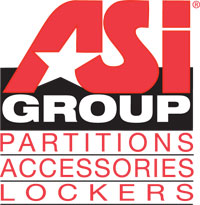 |
The ASI Group, whose mission is to make its customers successful by providing value that exceeds price and an excellent service experience, is comprised of four Division 10 manufacturers: American Specialties, Inc., Global Partitions, Accurate Partitions Corp. and ASI Storage Solutions. Together they offer a single-source solution for washroom accessories, toilet partitions, lockers and other storage products. www.asigroup.us |
